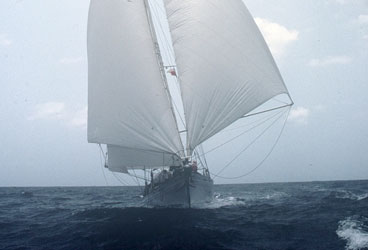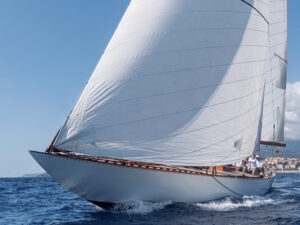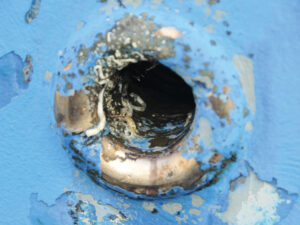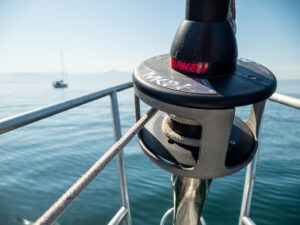
Trade-Wind Rigs
Everyone dreams of the perfect trade-wind passage in 15 to 18 knots of wind with long swells rolling up from astern and little necessity to do anything more than tweak the sheets and halyards to minimize chafe. But some years the trades blow 25 to 30 knots and churn up massive waves, while at other times, they die out for weeks at a time. For running before the trades, therefore, you must be rigged for all eventualities, and to do that, you’ll need a strong, easily rigged boom preventer, a reaching sheet that allows for a headsail to be sheeted through a fitting on the end of the boom, a dual-headsail rig, and spinnaker gear.
Boom Preventer, Reaching Sheet
To set up the preventer, attach a becket block to a bail on or near the end of the main boom. Then attach a wire or modern high-strength line to the becket’s eye. This wire/line preventer should be about 1 inch shorter than the distance from the becket block to the gooseneck. Splice an eye around a thimble into the forward end of the preventer line and attach a light lashing line to the thimble so it can be secured under the main boom when not in use.
Then rig both spinnaker-pole guys through blocks at the stem head or end of the bowsprit. The ends with snap shackles run back from the block on the bow to the lifeline stanchions on both sides of the mast. The other ends run back aft from the blocks on the bow to winches in the cockpit and get secured to a lifeline stanchion or cleat abreast of the cockpit when not in use.
When the time comes to set the preventer, disconnect the line on the boom and attach it to the lee spinnaker guy that’s stowed alongside the mast, then winch the tail of the spinnaker guy up tight as the main is eased.
Dual Headsails
The best downwind rig for trade-wind sailing is dual headsails. The windward headsail should be sheeted through the spinnaker or whisker pole. The leeward headsail should be sheeted using a line that’s led through the shiv in the becket block at the end of the boom. From the becket block, the sheet runs through a snatchblock amidships, then back to a cockpit winch. Sheeting the leeward headsail through the end of the boom minimizes backwinding of the mainsail by opening the slot between the main and the leech of the headsail.
To minimize rolling, the center of effort of both headsails should be low. I suggest flying two low-cut genoas rather than high-cut jibs. The flatter the headsails are sheeted, the less the boat will roll. Thus, the windward sail should be the No. 2 genoa; the leeward sail should be the No. 1 genoa. Both sails can be hoisted on a roller-furling headsail foil. If the two headsails are of different luff lengths, add a pennant to the shorter headsail to make the luff lengths the same.
If it blows up in squalls, or if the trades are really honking and the two full genoas are too much, just slowly ease sheets and furl the sails until the desired amount is still showing.
If the wind comes far enough aft so that the lee headsail is blanketed by the main, drop the main and sail under the two headsails alone. If the wind goes so far forward that the windward headsail won’t draw, just drop it out of the pole—the pole can stay there, as it has its own foreguy and afterguy plus the topping lift—and trim it in on the other side on top of the leeward headsail.
One headsail on top of another works fine, as Ted Turner established in the early days of the International Offshore Rule when he used two headsails set one on top of the other to maximize sail area in light airs. It was effective enough that the I.O.R. outlawed the practice.
For boats that have only one headsail, a second headsail will have to be bought. Remember: You’re cruising, not racing. Go to a company that specializes in second-hand sails and buy one of the approximate size that you want. Then take it to a sailmaker and have it restitched at the leech, the foot, and 3 inches in from the leech on all seams. This makes the sail strong enough for most conditions.
When it comes to spinnaker poles, a pole that’s 20 percent longer than the base of the foretriangle will allow a 135-percent headsail to set really flat, which minimizes rolling. Here is where a telescoping whisker pole earns its keep. Whatever diameter of pole the manufacturer recommends for your size of foretriangle, go one size larger. It’s worth the expense: An oversized pole minimizes the worry of it bending or jamming.
Whether or not a carbon mast is a worthwhile investment on a cruising boat won’t be discussed here, but if you can afford it, a carbon spinnaker pole is a very worthwhile investment. Depending on the material used, the weight of an 18-foot spinnaker pole can vary greatly: A wood pole weighs about 45 pounds; an aluminum one, about 35 pounds; a carbon-fiber pole weighs 18 pounds or less.
**
Spinnaker Gear**
If the wind goes light, roll up the dual headsails and set the spinnaker, but make an absolute rule that the spinnaker must be doused before any squalls arrive. Also make a rule that the spinnaker must be doused and the rig switched back to the dual headsails as soon as the wind speed reaches the square root of your waterline length plus 15 percent. Another good rule is to always fly the spinnaker with light—say about 3/8-inch three-strand Dacron—sheets. When it starts to blow, the sheets will tend to stretch and become smaller, and even the dimmest on-deck crew will observe this and call the skipper, who’ll then insist on dousing the spinnaker before it really blows.
When it comes time to douse the spinnaker, a snuffer is essential, and when buying a snuffer, no matter what size of nose cone the sailmaker recommends, consider going one size larger. Doing this will make it much easier to pull the snuffer down. I’ve found that leading the snuffer downhaul through a snatchblock set near the bow and then back through a snatchblock to two or more crew is much easier than having a single crewmember hauling down on the line up at the bow.
Snuffers do work, as long as they’re handled correctly. Before trying to snuff the kite, the boat must be headed dead downwind so the spinnaker can collapse behind the main.
Asymmetric spinnakers are great. Installing a removable bowsprit is worthwhile as it will make jibing the asymmetric much easier. Plus it allows you to sail deeper than if it’s tacked down at the bow. However, for a heavy- or moderate-displacement cruising boat, it’s essential that a spinnaker pole be carried in case the wind goes dead aft. Tacking downwind with an asymmetric is fast on light-displacement boats; however, a heavy-displacement cruising boat doesn’t increase its speed sufficiently to justify sailing jibe angles of more than 20 degrees. I learned this firsthand aboard an 88-foot ketch that sailed transatlantic in 2005. It sailed well but only had a big asymmetric without a pole. To keep the sail full, we had to sail 90-degree jibe angles. We were doing 9 to 10 knots through the water, but our velocity made good was only 6 to 7 knots on course to Antigua.
If you’re planning a trade-wind voyage, here’s one final consideration. With the right sails and rigging, trade-wind passages should be the ultimate in green transportation. So, just to keep your beer cold and lights lit, why ruin your wonderful time at sea by listening to an engine or generator for four hours a day and smelling the exhaust fumes blowing the length of the boat? Instead, you can trail a 12-inch propeller on 50 feet of line attached to an Ampair taffrail generator slung from the stern pulpit. I did this on Iolaire and can attest that if you have a day’s run of 160 miles, it will generate 144 ampere-hours at 12 volts.
Iolaire also has had a wind generator on the top of the mizzen since 1975, and it’s seen at least three occasions when the wind was over 70 knots. It didn’t work so well when running with the trades because of the lack of apparent wind, but at anchor, it easily kept the beer cold.
Running generators on passage is totally or almost totally unnecessary and definitely unacceptable if we’re trying to sail green and minimize pollution from internal combustion engines. The engineless Iolaire has done five transatlantics with cold beer all the way, courtesy of Ampair wind and water generators. You can read more about this in a CW web extra (www.cruisingworld.com/1105street).
Don Street is the author of a series of popular cruising guides and charts and appears in a series of instructional DVDs. Log on to www.street-iolaire.com to learn more about his adventures.








